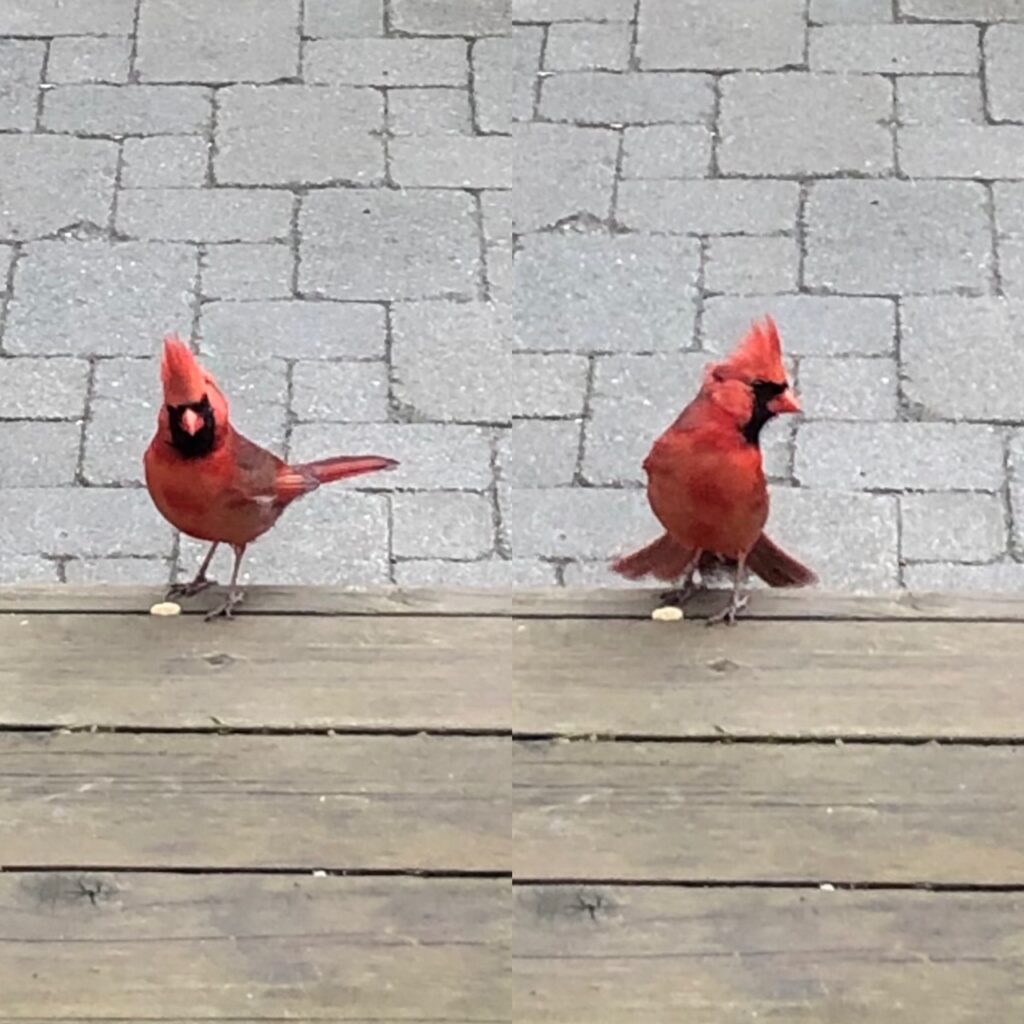
Today’s small joy: a morning visit from cardinal


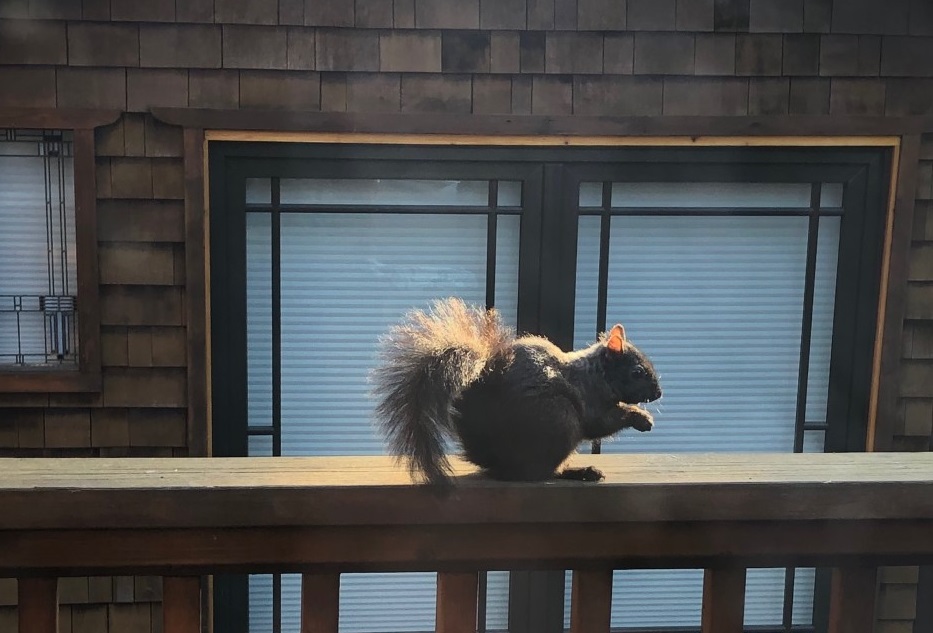
In the café of a trendy boutique hotel, my friend Tim and I were talking about books we had recently read. In reference to one, Tim, who grew up in a beautiful natural environment outside the city, commented that we can enjoy our city even more when we notice and appreciate the wildlife that is all around us.
Standing at a bus stop in east end Toronto on my way to work that day, I had heard exuberant calls of at least 4 different kinds of birds. Or maybe it’s different sounds from one or two different kinds of birds, I don’t know – but their peeps and yips and whistles were uplifting on a cold grey morning.
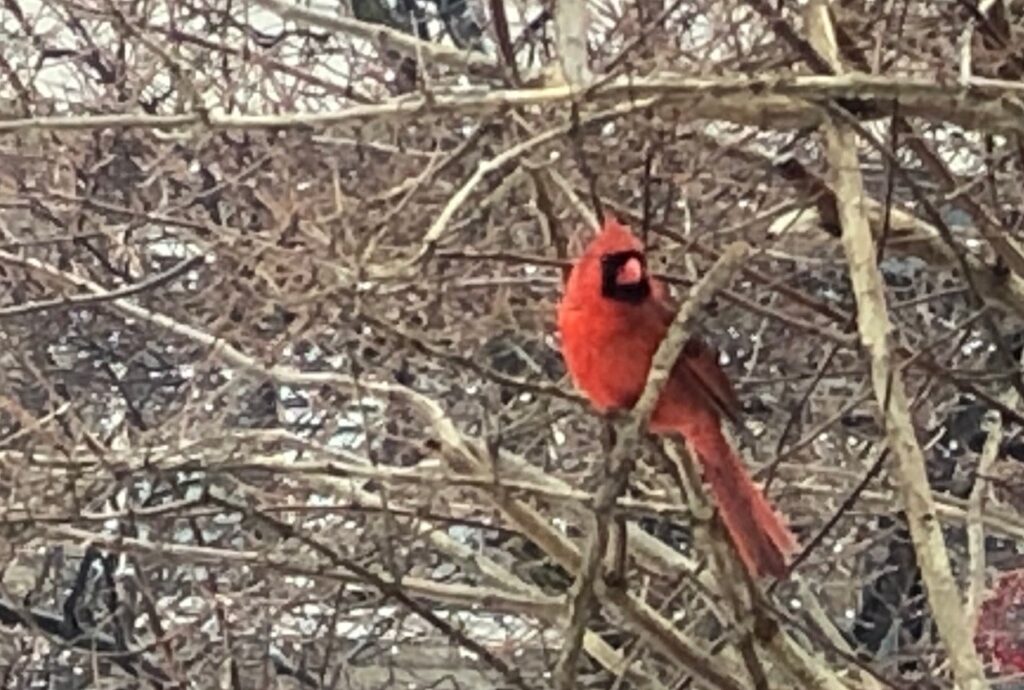
Yesterday morning my local racoon came for a neighbourly visit, which was a treat since she usually comes by at night to see if she can scrounge some tasty bits from the garbage. Squirrels scamper through our yard frequently throughout the day, though I see my little black-furred friends (and one grey one) mostly in the early morning before I go to work. And for the last couple of months a very vocal cardinal couple have been stopping for a visit in our front yard every few days.
I have no idea who else may be passing through when I am at work during the days and many evenings.
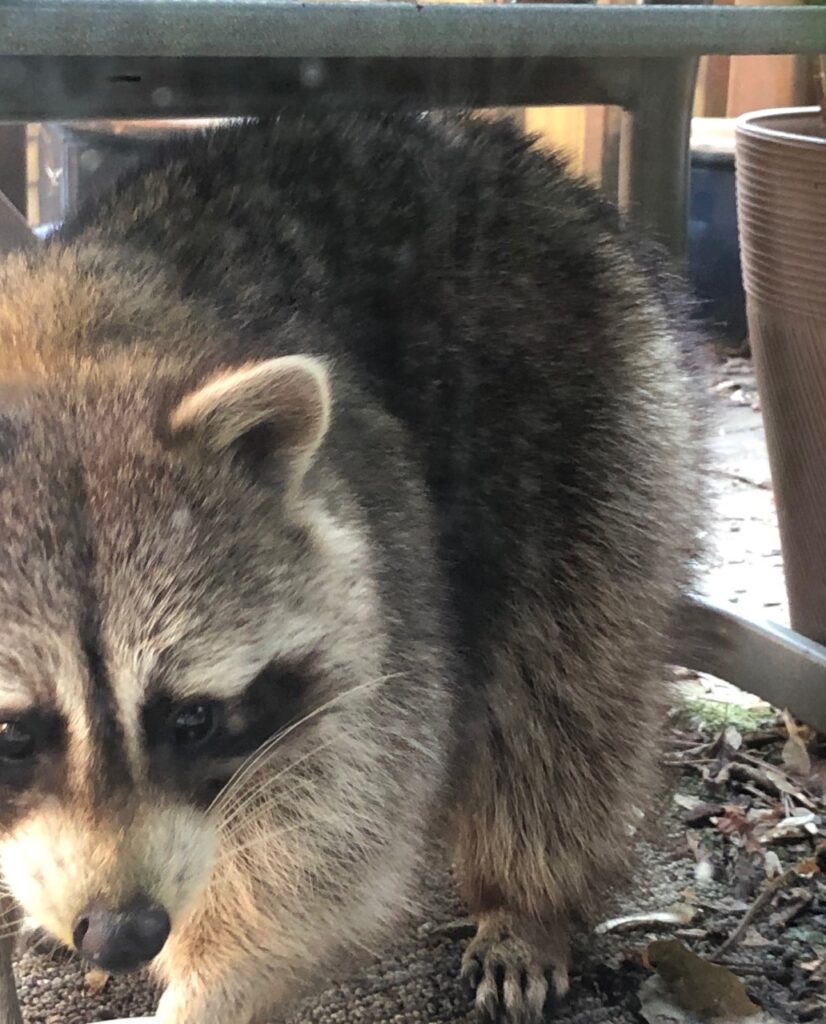
A few months ago, I spoke with an awesome 12-year-old girl named Adara, and her mom Kendra, about growing up in the city – with wildlife. Adara has watched at least three generations of falcons in her schoolyard and in her own back yard. “Two years ago, there were babies everywhere… you couldn’t wake up any morning without hearing falcons” Adara told me. “We don’t see them as much now, but they are still around.”
One of the raptors liked to roost in the tree right outside of Adara’s bedroom. The falcon would sit in the fork of the tall tree, where it could oversee back yards across the neighbourhood. Adara said, “One morning I woke up and I was like, huh, that’s a nice thing to wake up to! He would have come up to here [Adara karate-hand points to just below her knee] almost, at that time. And he stayed in that tree for about a year. He left around the time that the third generation of babies were born… there was six babies at one point constantly flying around.” So, their whole east-end Toronto neighbourhood was watching baby falcons.
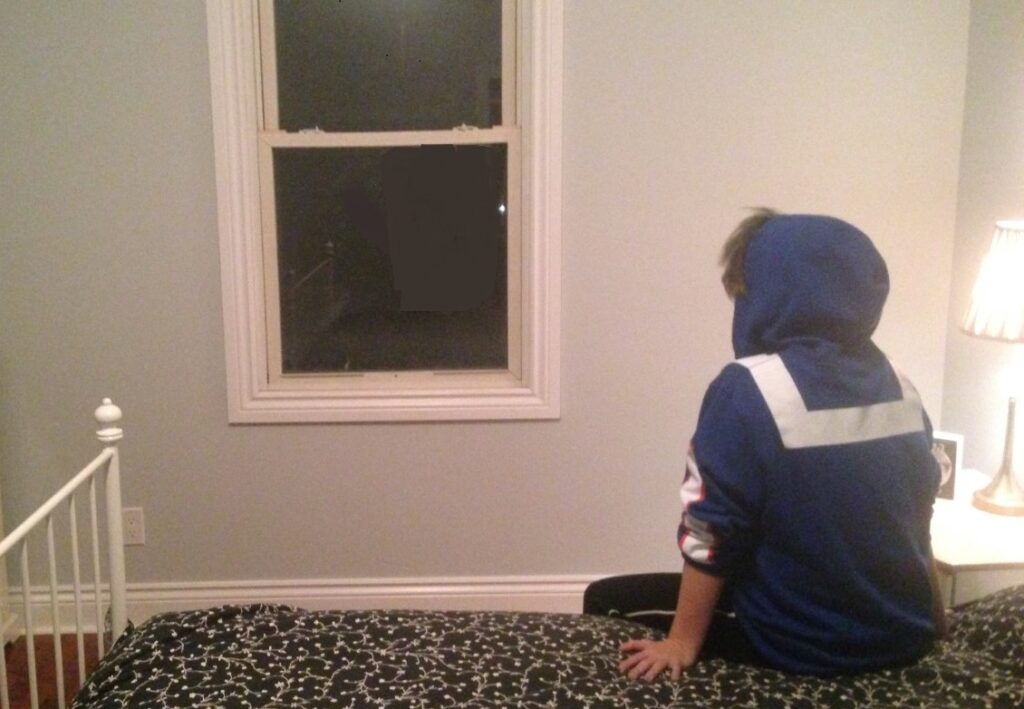
Opossums, raccoons, and other wild neighbours have been seen in Adara and Kendra’s yard, as well as coyotes in a nearby urban park. There’s also a skunk that has a regular route through the yard. “It has a ritual,” Adara says, “it comes up from between the two houses at about 11ish, wanders around the front yard for a bit, and then goes back down the driveway.” Kendra and her husband taught Adara that when the skunk is there, to be still and don’t surprise it – it will paw around the yard happily and everyone will be ok. Adara rolls her eyes as she describes the teenagers who scream and shout out when they see the skunk, and says, “really, you are across the road and you are fine.”
In the intro to Wild City, A Guide to Nature in Urban Ontario, Doug Bennett and Tim Tiner write, “Cities are commonly thought of as being outside of nature, and certainly there is no landscape more altered and intensely dominated by humans. … Certain native species, such as squirrels, crows, blue jays and raccoons, have learned to prosper in the new human-structured environment. Many others persist in the less-disturbed, protected or neglected spaces within cities. Their number and diversity may not rival that found in the near-pristine wilderness or even in the rural countryside, but for more than 80 percent of us in Ontario who live in urban environs, it’s the nature most immediate to us in our everyday lives.”
Mid-week last week (on March 4), the Government of Ontario made an announcement with the headline: Ontario Helping Communities Protect Species at Risk. Minister Jeff Yurek (Minister of the Environment, Conservation and Parks) announced that the government will again be investing to support projects by non-profit organizations, Indigenous communities, and other groups through the Species at Risk Stewardship Program. Up to $4.5 million in 2020-21. The program is designed to improve the status of species at risk and their habitats by supporting stewardship, protection, and recovery, as well as funding scientific research, outreach, and other activities that inspire and enable people to become involved in species at risk stewardship.
Ontario is home to more than 30,000 species of plants, insects, fish and wildlife. 243 species are listed on the Species at Risk in Ontario List, including some of my favourite critters: salamanders, owls, fox, woodpeckers, swallows and warblers, little bats, snakes, quite a few species of fish, dragonflies, voles, as well as animals I didn’t know we have in Ontario and others I had never heard of. The full species at risk list is online here.
In Our Wild Calling (one of the books that my friend Tim and I were discussing in the café), Richard Louv writes, “Here’s an additional possibility: As climate change and urbanization continue to move wild animals out of traditional habitats and into cities, multiple species will come into closer contact. If our species can devise new rules for living peacefully with other animals, and create additional natural habitat in cities, urban biodiversity will increase, and our species loneliness may be reduced. Creating that new compact will be key to our survival, beginning with our mental health.”
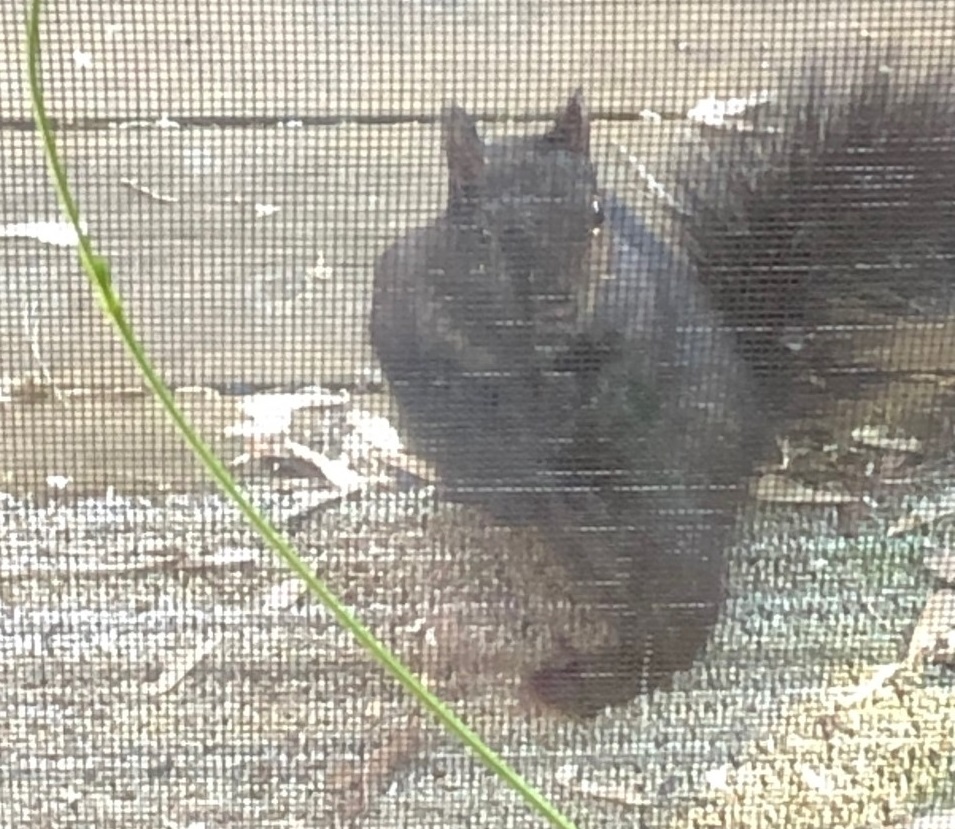
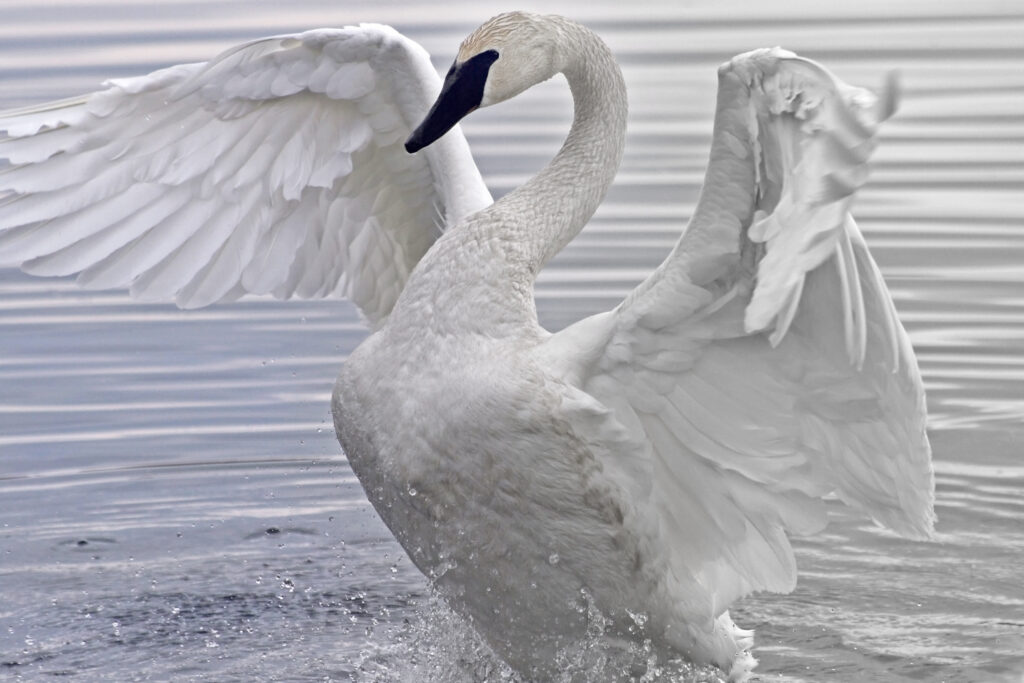
Three new swans are in care at the wildlife centre right now. All are victims of fishhooks.
Two are brothers, but they don’t seem to like each other much. Staff tried to place them in the same room together, and it didn’t go well. They are adult males and that rivalry overrides any family bonds. Two of the three birds are from Tommy Thompson Park, so I assume those are the brothers. They now each have their own large pool in their own care room.
In addition to Tommy Thompson Park, are also swans in High Park, Bluffer’s Park in Scarborough, LaSalle Park in Burlington, and other urban locations, but I don’t know where the third bird in care came from.
The New York Times reported in spring of last year: “Restoration efforts in Ontario, Canada, have helped a once-vanquished population to flourish. And they have been sighted in new habitats in the United States, too.”
“Winter is a social time for swans and as a result we often see as many as 100 swans coming from further north to enjoy their ‘social afternoon,’ says a Toronto Region Conservation Society article about the Trumpeter Swans in Bluffers Park.
This is the time of year when the Trumpeter Swan Restoration Program will tag and band as many untagged swans as possible “so that the Trumpeter Swan Restoration Program can follow their progress, breeding patterns and degree of success in relearning their migratory routes. Tagging the swans lets us not only track their movements, but also to understand their behaviour.”
“Bluffers Park has been home to a breeding pair for over 25 years. The previous male, Charley or Whitey as he was known, was a huge favourite in the boating community and he was here for almost 20 years. Unfortunately, he had to be put to sleep after a deadly encounter with discarded fishing tackle.”
Every year, Toronto Wildlife Centre admits animals that have been affected or injured by discarded fishing equipment. “Hooks can get embedded and cause infection and injury, lines get tangled around feet and wings and impede mobility or cause constriction issues, and sinkers when swallowed can cause deadly lead poisoning,” says the TWC.
The swans, ducks, and other aquatic birds affected often need x-rays and surgery to remove the metal paraphernalia and repair the internal damage. Then lots of care to heal before being ready to return to the wild.
And I gotta say, from what I have seen so far, swans are not easy patients! They can be spazzy and pool-jumpers. (Getting out of their care pool can be dangerous for the swans, as they can get injured.) They are often stressed out, aggressive, feisty, and want to get back to their home and mate.
Shockingly, I just read that, despite being native to North America, thirty years ago there were no trumpeters left in Ontario. What??!!?
Margaret Bream wrote in a Toronto Star article that, “Trumpeter swans …were once found on a large swath of the continent. But the huge birds, the largest waterfowl extant in the world, were hunted to the brink of extinction in the last century, with only a few small colonies remaining out West. The birds were prized as food, their extremely long white feathers and their leather. … But Lumsden [Harry Lumsden, a retired Ministry of Natural Resources biologist and founder of the Ontario Trumpeter Swan Restoration Program] obtained a few wild birds and eggs from the Western colonies, brought them back to Ontario and raised them as coddled captives. When the birds were a few years old and ready to fend for themselves, they were released back into the wild in this province.”
Harry Lumsden, who founded the Ontario Trumpeter Swan Restoration Program, was honoured with the Order of Canada in 2004. The Governor-General’s news release said, “he has shared his knowledge of aviculture with the general public. He has inspired volunteers to follow his lead in breeding Canada geese and trumpeter swans, successfully reintroducing these birds to Ontario. Known for his passion and dedication, he continues to stimulate public interest in wildlife conservation.”
The Trumpeter Swan Society website says: Trumpeter Swans are native only to North America. They are the largest waterfowl in the world. Although most populations are increasing, they are one of our least abundant native birds with about 63,000 Trumpeters on the entire continent.
The Society website also says that swan parents teach their young migration routes, wintering sites, and how to survive in the wild. Sadly, with the near extinction of Trumpeter Swans, came the loss of migration traditions and knowledge of local landscapes. Swan restoration programs in the 1980s was with eggs from Alaska. The swans hatched from those eggs had no knowledge of their new landscape. As swans began to slowly return to the landscape, they had to pioneer and learn new migration traditions, find secure wintering sites, and discover nesting habitat in areas where they had been gone for more than a century.
There is a “Trumpeter Watch” where anyone can report a Trumpeter Swan sighting. This helps swan managers across North America to track where the swans are spending their winters and summers, and the migration time in between. You can report a swan sighting here.
Turtles, birds, fish, and raptors like hawks and owls who hunt near water, are all frequent victims of fishing tackle garbage. If you see an animal who is tangled in fishing line, or if you know a wild animal has swallowed a hook, contact a permitted wildlife rehabilitator for advice. If you are in the greater Toronto area, you can call the Toronto Wildlife Centre Hotline at 416-631-6002 and there is an assistance request form online here.
“To form a perfect conception of the beauty and elegance of these Swans, you must observe them when they are not aware of your proximity, and as they glide over the waters of some secluded inland pond. On such occasions, the neck, which at other times is held stiffly upright, moves in graceful curves, now bent forward, now inclined backwards over the body. Now with an extended scooping movement the head becomes immersed for a moment, and with a sudden effort a flood of water is thrown over the back and wings, when it is seen rolling off in sparkling globules, like so many large pearls. The bird then shakes its wings, beats the water, and as if giddy with delight shoots away, gliding over and beneath the surface of the liquid element with surprising agility and grace. Imagine, reader, that a flock of fifty Swans are thus sporting before you, as they have more than once been in my sight, and you will feel, as I have felt, more happy and void of care than I can describe.” — John James Audubon (1843)
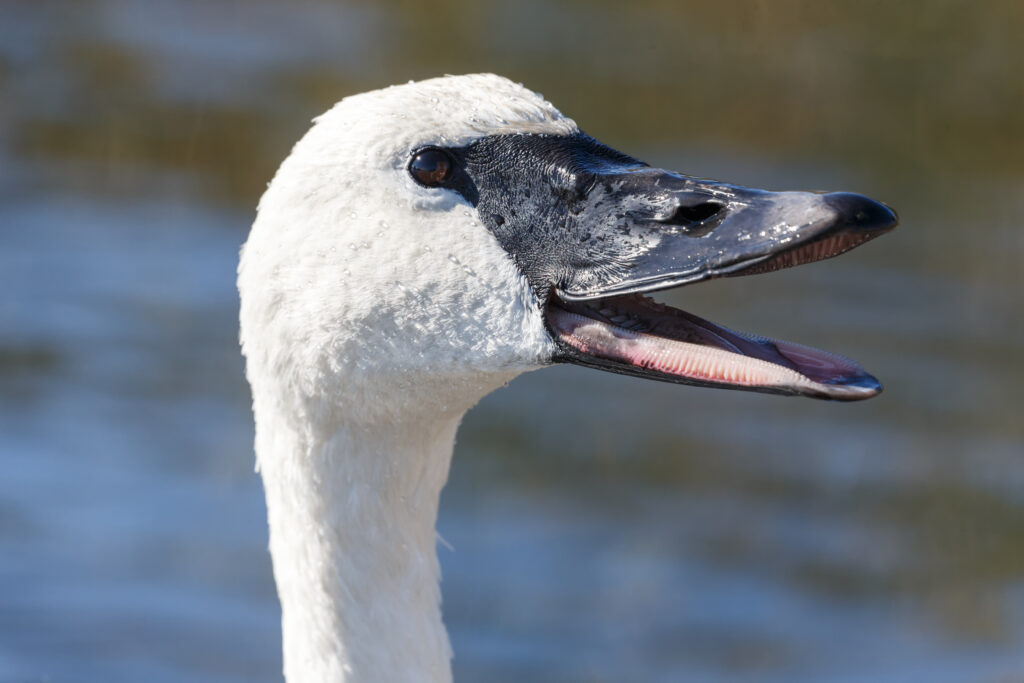
A few resources:
Toronto Wildlife Centre is Canada’s largest and busiest wildlife centre, and the GTA’s only wildlife hospital: www.torontowildlifecentre.com
The Trumpeter Swan Coalition is committed to ensuring LaSalle Park Harbour, the winter home of 1/4 of Ontario’s Trumpeter Swans, is protected: www.trumpeterswancoalition.com
The Trumpeter Swan Society has been North America’s leader of Trumpeter Swan conservation with a mission to assure the vitality and welfare of wild Trumpeter Swans: www.trumpeterswansociety.org
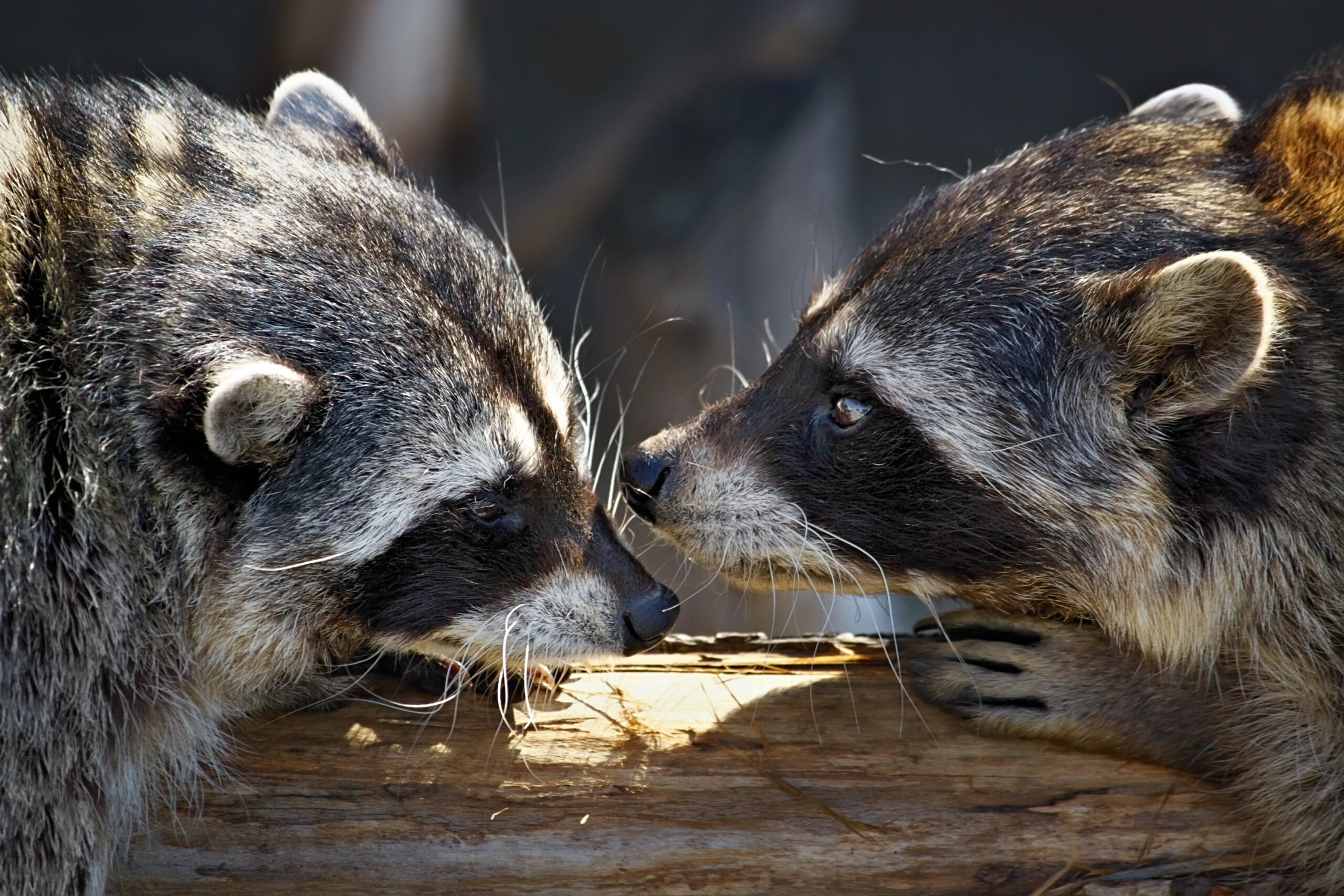
Did you know that it is now raccoon mating season?? I sure didn’t. Maybe you have been hearing raccoon fights in your backyard or alleyway. Aside from the raccoons in care at the wildlife centre, I have not seen a raccoon since last autumn. And now there are so many raccoons in care at the Centre that it’s getting tricky to find rooms and enclosures for them all. I asked the staff why we are getting so many raccoons right now. And that’s how I learned that it’s mating season.
Male raccoons are coming in to the Centre with wounds and abscesses on their backs from fights with other males. They really fight! Not just a show of aggression to scare away the other male. They scratch, bite, and apparently even bite-throw each other, as they fight for a female.
I would have never thought I’d be curious about the sex life of racoons, but it is Valentine’s Day and Family Day long weekend, after all…
Male raccoons are promiscuous. After mating, male raccoons sometimes stay with the females for up to a week before searching for another female. And the bigger a raccoon is, the more action he gets. The most dominant heaviest male will do 50-60% of the mating with the females within the group’s territory, says the Wildpro Electronic Encyclopaedia.
Female raccoons usually mate with only one male. They only have a small window of time – only three or four days per mating season when they can conceive. Raccoon Attic Guide says that “during the three to four days in which conception is on the table, raccoons will meet as a social group, foreplay and copulation being repeated during these nights, with sessions that last for about an hour. And while the strongest male will always get the chance to ensure the survival of its genes by copulating with more females… [he] can’t possibly mate with all the available females, the weaker males also eventually get the chance to breed. The urban female raccoon will give birth to an average of two to three litters during her lifetime.”
After gestation of about nine weeks, the female raccoon gives birth to three or four kits usually. The babies are born blind and deaf, but their face masks are fully recognizable. Their eyes and ears open at around three weeks, and by about 7 weeks old their eyes can focus. The kits remain in the den until they are 8-10 weeks old and will stay with their mother for a year or so. The mother raises her kits alone.
Mating season means injured raccoons coming in to the Toronto Wildlife Centre now, but it also means that it will be time for orphan and injured babies to come in starting around April and May.
According to PBS Raccoon Nation, in the wild a raccoon has a life expectancy of about 2 to 3 years, but in captivity a raccoon can live up to 20 years.
Fun fact I discovered (thanks to Wikipedia) while looking into raccoons: The word raccoon in English is based on an Algonquian (Powhatan) word meaning “he scratches with the hands.” Similarly, the Spanish word mapache is based on an Aztec word meaning “one who takes everything in its hands.” But in many other languages, the raccoon is called a wash bear: Waschbär (‘wash-bear’) in German, Huan Xiong (‘wash-bear’) in Chinese, dvivón róchetz (‘washing-bear’) in Hebrew, orsetto lavatore (‘little washer bear’) in Italian, and araiguma (‘washing-bear’) in Japanese.
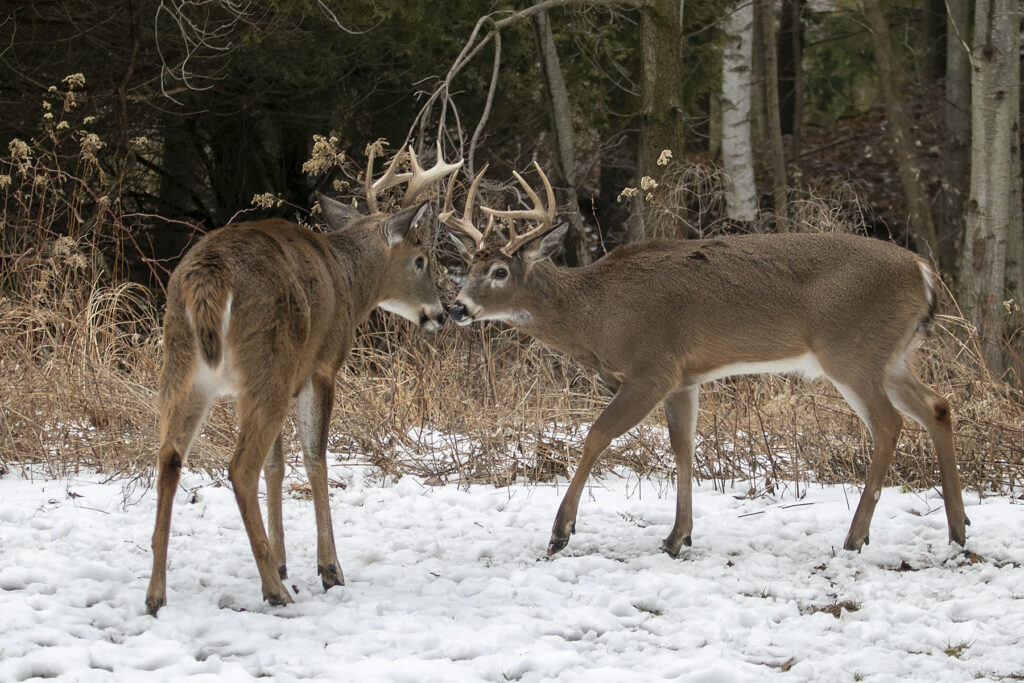
Ann Brokelman spends every day out in Toronto’s parks and wilder areas, with her camera and a coffee. Since retiring from the City of Toronto’s Arts & Culture division 4 years ago, she has enjoyed countless hours watching and photographing Toronto animals, from buck to beaver (that is just today!), coyotes, fox, birds, and every other local creature you can think of.
A “Wildlife Photography Safari with Ann Brokelman” was one of the silent auction items at the Toronto Wildlife Centre’s Wild Ball last November, donated to raise funds for the TWC. When I commented to other Wild Ball volunteers that night about how awesome the photography safari would be, I heard from them that Ann is a wonderful photographer and might also be a TWC volunteer. It turns out that she is both.
Ann has been a wildlife photographer for more than 13 years. She also helps with Toronto Wildlife Centre animal rescues, and she has been part of hundreds of releases when an animal has healed or grown enough to be returned to the wild. She photographs many of the releases for the TWC.
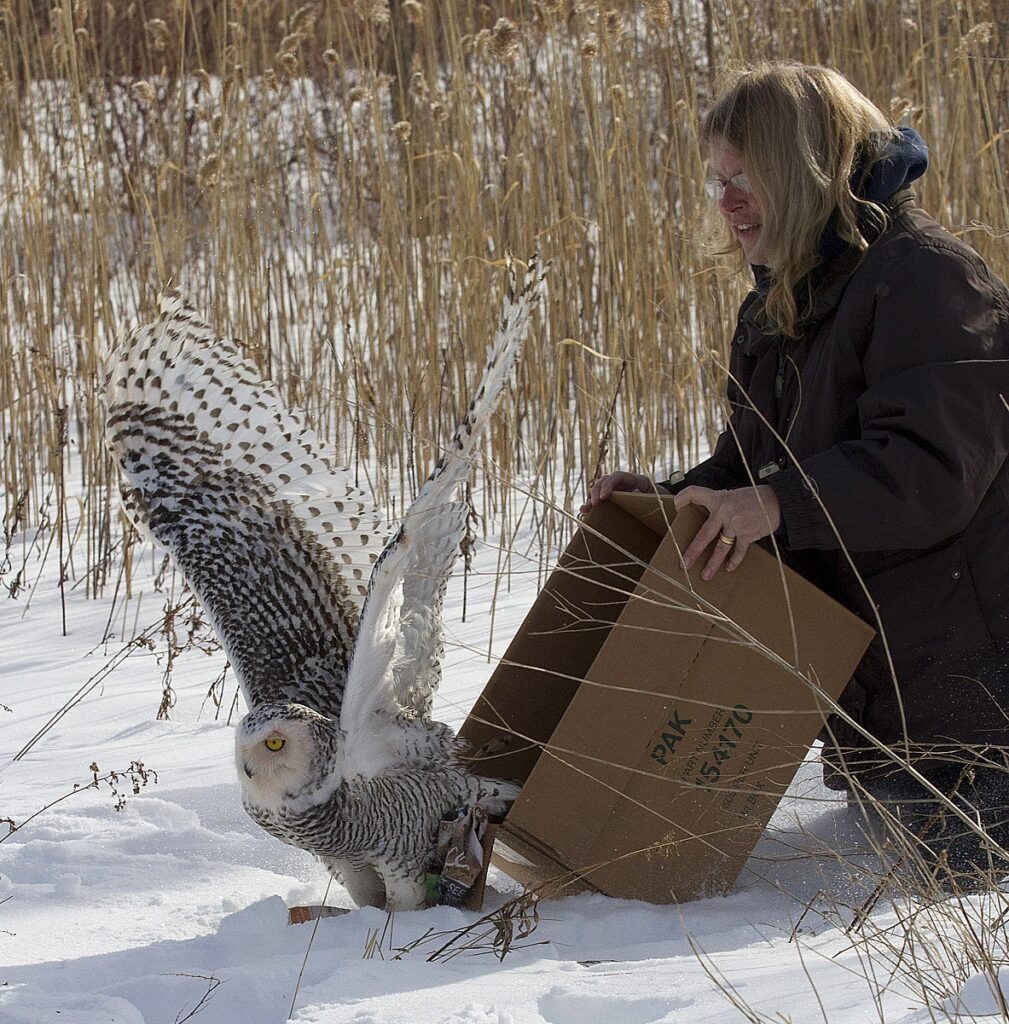
Her Wildlife Photography Safaris were created when Ann was looking for a way to donate to the Toronto Wildlife Centre. She thought, “I know where the animals are in Toronto, so why don’t I take people with me.”
On her first safari, three years ago with a woman who works as a neurologist, they saw 67 different species in one day. They were out from 8am until 6pm. Ann says, “we were on a roll… baby hawks, baby swans, baby ducks, baby deer … we just kept going because it was one of those things – this is the only chance!”
It was a friend of mine’s birthday last week. I had been thinking for weeks about what would be a super special gift for her. My friend is a birder and co-founded the Toronto chapter of a bird watching group, and a gardener, and photographer with a new camera she is getting to know. I thought of the photography safari auction item at the Wild Ball, and contacted the TWC’s event manager, Elena. She contacted Ann. It turned out that yes, Ann does offer Wildlife Photography Safaris year-round, to anyone who would like to go on one. A portion of her fee goes to Ann to cover costs and the rest goes directly to the Toronto Wildlife Centre as a donation. The perfect gift for my friend.
To prep for each full-day or half-day outing, Ann asks people which animals they are most interested in seeing. She says, there are some animals she can pretty much guarantee could be seen every day. Others, of course, are seasonal.
Guests on Ann’s safaris have the opportunity to use her camera. (A Canon 7D Mk with a 400mm prime lens.) The lens is crucial for getting clear colour-rich photos of animals and birds from a distance. Also, “you can see behaviour so much better by taking a short 30 second clip,” she says of the chance to video record using her equipment. If the person prefers to use their own equipment rather than her camera, Ann will take a few memory photos of the day.
One of the safaris she guided last year was with a fellow who was thrilled with the wildlife images he got, including Red Tailed Hawk babies. Ann tells me, “These babies were about 3 weeks old and they were dancing! So I suggested that he video record them. The adult came in with food and he captured all that on video.” This safari guest was a photographer with his own equipment that he used most of the day, but he used Ann’s long-distance lens and the video capabilities of her camera to be able to get the shots that were so special to him.
A Wildlife Photography Safari full day is around 6 or 7 hours, including driving to locations, walking, and enjoying the outdoors. Ann likes to help people understand the animals they see and why they are seeing it – all of the things that make it interesting.
She shows her guests things like how to stand to get great photos, how to use her camera, and “I can give people background of what has happened and what will happen next with the animal.” She says, “I try to teach the person about what we are seeing, what’s going on, what to expect, why the animals are here, what they are doing, what’s going on with them this time of year.”
“More than just taking pictures, it’s what’s going on in nature and in the world.” – Ann Brokelman
“Right now there are Snowy Owls all over the place – there are 8 that I know. In May, the little birds are coming through, and there are 5 locations I go to. When photographing birds, what I am looking for is colouring. I want to see what colour the beak is, I want to see what colour the feathers are, what colour is the fur and is it healthy, what colour is their tail, are all of the tail feathers there… all of those things are important to know when you are taking photos. There are also techniques for how to get the animal’s eye in the light so you get the glint – that is what makes the photos come alive.”
She brings a monopod or tripod, as well as her two all-time favourite books: Behavior Of North American Mammals by Mark Elbroch and Kirk Reinhart (which she found in Muskoka, and I intend to find online) and The Sibley Guide to Bird Life and Behavior by David Allen Sibley, which she received as a gift from a friend. “I really love to study and read about animals. I carry these books with me and if I see something unusual, one of these two books will usually explain what is happening.”
After the day of photographing wildlife, Ann adjusts the best of the photos in Photoshop and provides all of the images from the day as large Jpgs on a USB key for the safari guest to keep.
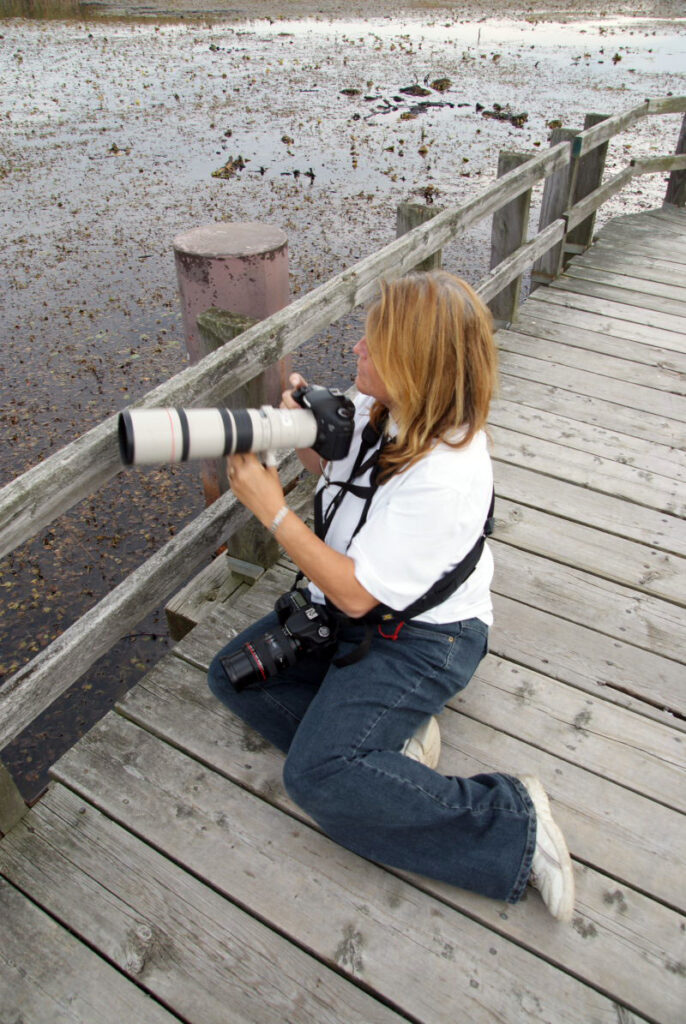
When I spoke with Ann on the phone at 5:30pm, she had just arrived home after being out since 12:30pm. She said, “Today I picked up a coffee pulled up into a park with my camera, my coffee, and my purse. I went for a walk and saw nothing. Then on my way back to my car I saw a buck! I got photos of two bucks together with a young buck. And a strange thing happened. One of the bucks put its head between female’s legs and picked her right up off the ground. I thought, what is going on? Rutting season is in November. And what is he doing with horns still… they should be gone this time of year. I will investigate… this is unusual behaviour for this time of year.”
At that same park this afternoon, a woman asked Ann if she had seen the beavers. Ann had replied that she hadn’t seen the beavers for quite a while. So Ann went over to where the beavers are, watched as one cleared the bark off a branch, finished and tossed it away, and got another branch to work on. Ann got some wonderful photos of the mom and the baby beaver above the water. A particularly special treat, since it is the first week of February, and a thick layer of ice is usually covering the water.
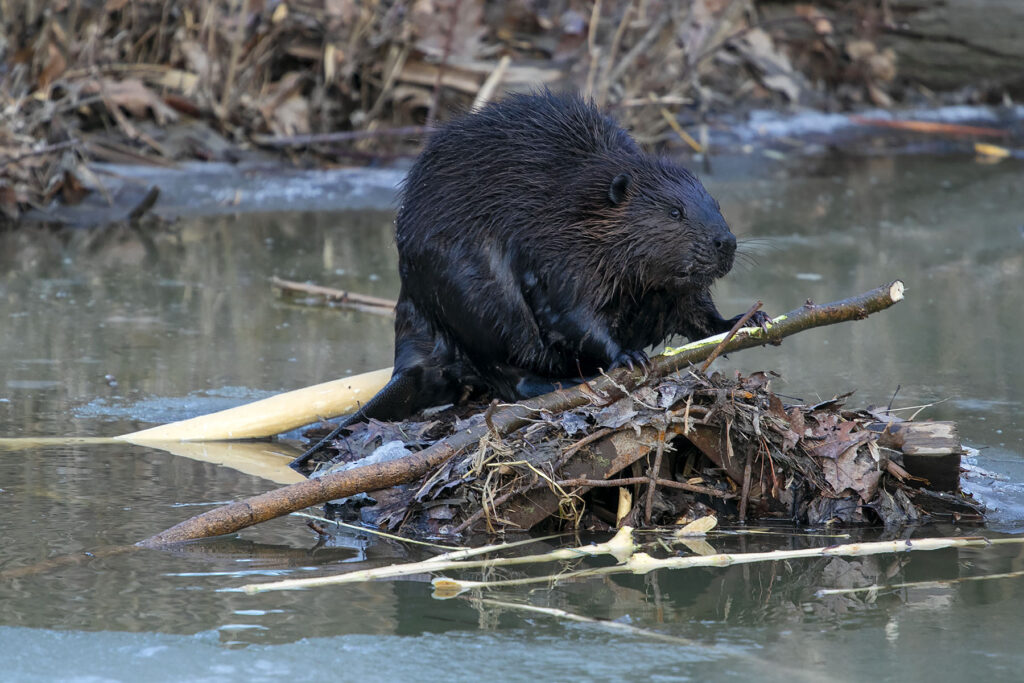
“I live and breathe nature,” she says. “Even at my house we have cameras and night vision cams all over the place. It is especially great to see the animals’ behaviour. There is a fox who pees in the exact same place every night.”
“Today I spent a lot of time videotaping and took a lot of photos… I can just watch the animals as well – I don’t need to take images. When I take someone else out with me, I don’t shoot – I focus on their experience.”
“I could tell you the story of every photo I have ever taken – where I was, when it was, who I was with. A beautiful shot and a beautiful moment become a memory.
I am a memory photographer.”
Photographer and Toronto Wildlife Photography Safari guide Ann Brokelman volunteers for Coyote Watch Canada, Shade of Hope, Toronto Wildlife Centre, and The Owl Foundation. She also writes “On the Wild Side” articles for Beach Metro News.
She can be found online at:
Ann Brokelman Photography in the Wild
Nature Photos By Ann Brokelman
Ann Brokelman’s On the Wild Side articles in Beach Metro News are here
A gorgeous story featuring Ann Brokelman’s images in the Niagara Escarpment News is here
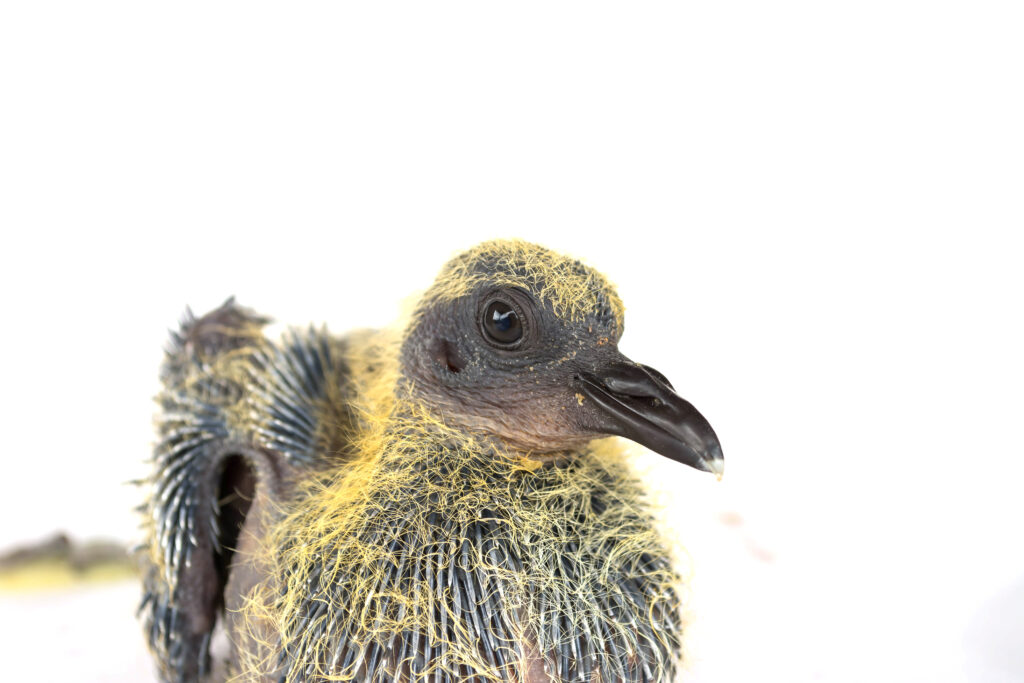
[A prose poem by Heather L Kelly]
The middle of winter, no mother, she cries for food, she cries for comfort. The plush stuffed dragon with pink wings in her enclosure to calm her is cute but … not interacting with her, not responding. Little peeps, loud peeps. She is calling for food, for love, for attention. She is a baby. Bird. She doesn’t know she was born a species that people call names like rat – another who is intelligent, affectionate, misunderstood. She doesn’t know what happened to her mother. Or maybe she does, and has nightmares. Where are her brothers and sisters. She calls out, loud peeps, I am here! I am here! Here! Here! Someone please feed me! Someone! I’m hungry! I am a baby and I am here in the strange place and I can’t get my own food. She calls out, someone hear me! Feed me! Hear me! All of the adult pigeons, in separate cages lined up along the counter, hear her. We humans, hear her, down the hall. The other pigeons hear her. None are her mother, the other pigeons can’t help her. They are isolated, they are there to heal from some other trauma. They are city birds, more likely to be burned from hot cooking oil in an alley than in a forest fire. These are city birds, our neighbours, our local babies, this baby. This mid-winter baby calls out, loud peeps. She calls out for food, she calls out for attention. A squab, rock dove, a mess of baby fuzz on her head. Not yet the iridescent plumes of her elders. Alert eyes, flappy flappy flappy fear when I come too near. To cuddle her would be terrifying and dangerous for her. To tell her everything will be ok would be untrue. But to love her, and feed her, is something we can do.
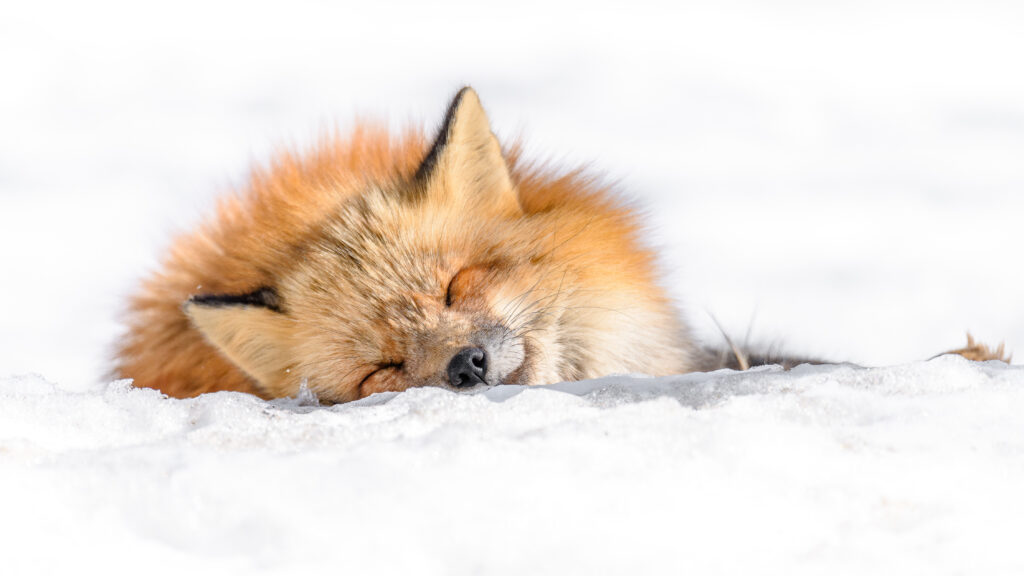
Torpor. It sounds like a weather phenomenon. Or a piece of outwear. The word makes me think of stupor. It’s a word I have never thought about. But during this week’s TWC shift, as people spoke of the bats being in torpor and other animals we have in care who should be hibernating, I started to think, hm. Okay, what is the difference? And do humans also experience a form of torpor, is that why we are all so damn tired this time of year?
So I looked into it and here’s what I learned.
Hibernation is extended torpor. It’s all about saving energy. It is a state of inactivity that is technically a regulated state of reduced metabolism. Breathing and heart rate slow down. Body temperature decreases.
It is not a state of sleep, as we often think. Humans lower their heart and respiratory rate every night when they go to sleep, but torpor is much slower. University of Oxford neuroscientist, Vladyslav Vyazovskiy, wrote, “some scientists suggest that, although we tend to think of hibernation as being like a long sleep, torpor actually creates a sleep-deprived state and the animals need to regularly compensate for this.”
Most animals go into torpor to avoid the cold or heat, but sometimes it has to do with availability of seasonal food sources, avoiding predators, and it can help an animal resist parasites.
According to the Encyclopedia Britannica online, “The torpid state may last overnight, as in temperate-zone hummingbirds and some insects and reptiles; or it may last for months, in the case of true hibernation and the winter torpor of many cold-blooded vertebrates.”
Apparently some bears go into torpor but not deep hibernation, and others go into hibernation. Deep hibernators include chipmunks, garter snakes, and toads.
Racoons, deer mice, skunks, bats, turtles, and even fish like cod and koi, are among the animals that go into torpor but not full hibernation.
Bumble bees hibernate, but honey bees don’t – who knew. (Ok, I know that you, reading this, likely knew.)
Wild turkeys do not hibernate. Gray squirrels, voles, coyotes, red foxes, and opossums will create warm winter dens but they don’t hibernate, either.
Among the birds, torpor occurs in hummingbirds and swifts, nighthawks, and some others.
According to BBC Earth, “Hibernation and torpor are clearly millions of years old. For instance, all three major groups of mammals have evolved the techniques, and those groups diverged tens of millions of years ago. That suggests that at least some of the animals humans are descended from could hibernate. However, we seem to have lost some of the key abilities. For instance, our hearts cannot work if they get too cold.” Also, animals in hibernation don’t urinate or defecate.
That is not stopping scientists from investigating the possibilities of engineering a human hibernation, primarily for astronauts and space travel.
Kelly Drew, a neuropharmacologist at the University of Alaska Fairbanks who studies the brains of hibernating Arctic ground squirrels, is consulting with a company called Spaceworks Enterprises on a NASA-funded project to put humans into hibernation for spaceflight. The University of Oxford’s Vladyslav Vyazovskiy, mentioned above, is part of a team of experts organised by the European Space Agency to work out whether and how we might be able to put humans into a state of stasis. Anaesthesiologist Rob Henning of the University of Groningen in the Netherlands is working with NASA on exploring the possibility of engineering human hibernation to protect astronauts health in space. It appears that hibernation protects from muscle and bone loss.
Buddhist monks are the only humans who appear able to enter a state similar to torpor currently, as they have been known to lower their metabolism by more than 60% through meditation techniques.
I am so ready for a nap. Ciao for now.

“This is a Dusty original…” is the first thing I hear as I walk into the Olga Korper Gallery. To my left, artist Ken Nicol is beside a piece of artwork, and speaking to a group of thirty-somethings. He takes the piece of art by its white frame and lifts it off the gallery wall.
He shows the group the back of the frame, “….and this is Dusty.” It’s a photo of a black squirrel with fluffy orange tail, holding her half eaten almond, looking directly at the camera.
This exhibition, the laughter between two miles, is a Ken Nicol exhibition “with special guest Dusty the squirrel.” There is a series of three of Dusty’s art pieces in the middle of the largest wall in the exhibition. And there is this stand-alone piece near the entrance.
Ken’s work is precise, pattern-based, and, to me, irresistibly captivating. Words, weaves, lines – all patterns. Each with an interesting backstory or concept. There is a lot of containment. Like index card forms in a page, and teeny boxes in tiny boxes. He also plays with the idea of a “line” with grid lines, lines of text, lines representing distance, and referencing the line “no ifs, ands, or buts” in a hilarious piece where he has connected all of the ifs, ands, and buts in the text with straight lines.
One of the enthralling aspects of his work is the visible variations. The same but different. Being able to see a weave get smaller and tighter. Lines getting lighter or darker using different hardness of pencil lead. And in one of the series, Sol Lewitt sentences on conceptual art are numbered and typed on a page. A grid of four pages is created with the typed page plus three other pages of what looks like the exact same typing backward and upside down – but those pages are actually hand-rendered. Represented by Olga Korper Gallery, his work has been purchased by the Art Gallery of Ontario, and has been shown in exhibitions in Toronto, Hamilton, and New York.
Dusty’s art is more minimal, though she uses an understated colour palette similar to Ken’s. Her subtle paw gestures are very in the moment and a little unruly. She leaves whitespace around the markings, appearing deliberate in her movements yet aware of the element of chance in the creation of her work.
Now, full disclosure: I’m not an expert on professional squirrel art. I’ve worked on fine craft, visual art, and photography exhibitions, as well as performing arts for many years. But I am not qualified to assess squirrel art. So with that in mind, I will just tell you my personal reaction:
I love Dusty’s work. It encapsulates the speed of squirrel life. It appears to be a meditation on and celebration of being one’s true self. And it seems to address the idea of evidence of each individual’s existence.
In front of Dusty’s three mid-sized art pieces in the middle of the gallery, Director Shelli Cassidy-McIntosh said, “Ken had these papers ready to roll for something bigger, and Dusty had other plans … so Dusty gets a cameo in the show.”
“I have squirrel friends.” Ken told me as he showed me a video of a sweet black squirrel who he met on the street. I can relate, as can many other Torontonians.
“There’s Deedee, Mimi, the original window squirrel, Gerald…” There are so many, he doesn’t call all of them by name anymore. They come to his shop window, and he lets them in, feeds them almonds. Some of them make art on his prepared paper.
His squirrel pals (at least the most talented and ambitious artists among them), are fortunate to have befriended an artist who is opening art world doors (and windows) for them.
Ken showed me a brilliant video of Gregory squirrel in his studio, black furry body flying through the air toward the camera. It’s amazing. And in a photo of DeeDee, a grey squirrel, she looks very happy and comfortable posing on a beam in the studio.
I asked Ken if it freaks him out to have squirrel chaos in his studio. He answered by explaining his three-part Francis Bacon piece on the wall to the right of the gallery entrance.
Ken asked me if I knew anything about Francis Bacon’s studio. I said no. He explained that Bacon’s studio was a disaster. A total mess. The work of Ken’s on the wall here is a quote from Francis Bacon that says: “you can see an advertisement, you can see something lying in the street, anything can stimulate and excite you into wanting to do something it doesn’t have to be a great or remarkable thing it could just be lying on the floor “ francis bacon
The quote is on three pieces of paper, each framed. “This piece I had in my pocket for a year.” That version is in a grid pattern of small rectangles, some that fell apart along the fold lines. “And this piece I had in my bag for a year.” The middle piece is ragged around the edges. “And then this piece I had in my shop for a year, but I was kinda disappointed that nothing happened to it.” The final piece looked perfect. No marks or damage whatsoever.
On the other side of the entrance, the piece I saw first as I arrived was created by Dusty on March 18, 2019. As Ken put it on his wonderful blog every3point65, “…there was an incident… dusty hopped in through my window and kinda freaked herself out then bombed around my studio like a jerk. She put a couple footprints on my next mile. Luckily I had only put down the grid, but that takes most of a day and I had to start again. …”
Ken Nicol’s work in the exhibition was selling for $3,500 – $40,000. Dusty’s pieces are priced at $1,200.
the laughter between two miles exhibition ended on November 16. But I believe that Olga Korper Gallery now represents them both.
The Olga Korper Gallery can be visited online at olgakorpergallery.com or in person at 17 Morrow Avenue, Toronto.
Ken Nicol’s work and blog can be found at k-nicol.com
Keep an eye out for a Dusty the squirrel artist website in the future.
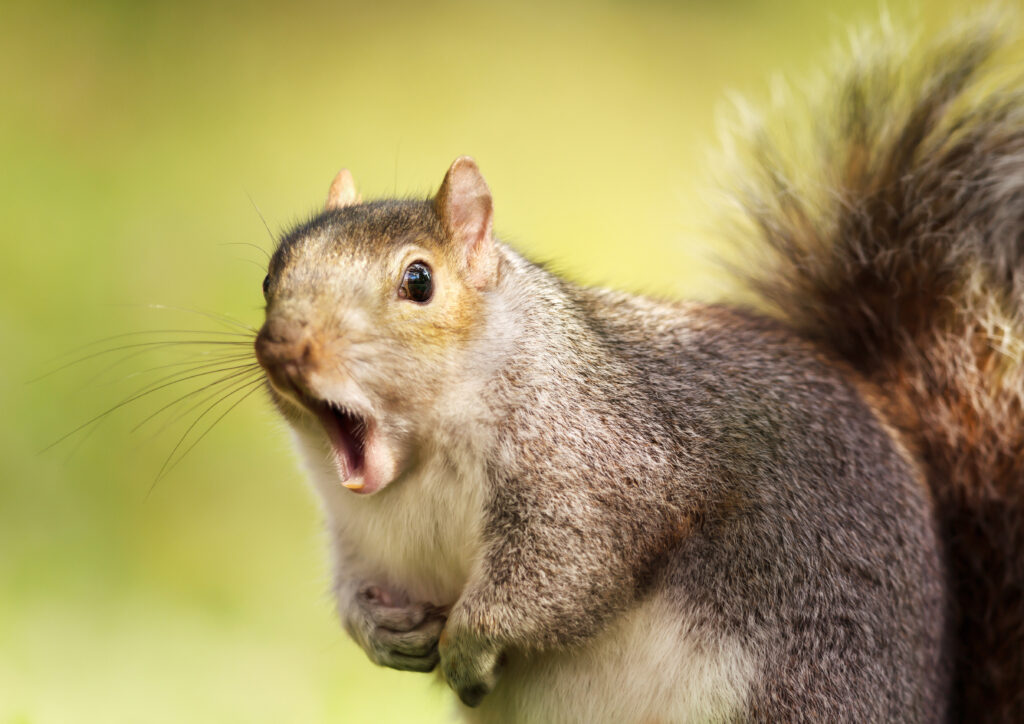
As soon as I arrived in the nursery room I was concerned about very loud, deep, growling and yelping. It was coming from one of the enclosures where there was also a lot more frenetic movement than usual. The vocals were coming from a grey squirrel. It was in an enclosure with a black squirrel who was hiding in a box.
I looked under the sheet covering the enclosure from time to time. Trying to figure out what was going on. The grey squirrel would climb quickly around the enclosure, and periodically stop on its back, fuzzy white and caramel-coloured belly exposed, growling loudly. I am not sure what kind of behaviour this is, but it is unsettling.
It seemed like it was being bullied or was bullying the other squirrel. I mentioned the very vocal sounds and strange physical behaviour to staff member CA. She told me that they had just been put into the same enclosure together and needed to get to know each other. I was scared they would stress each other out or kill each other before they settled in together as roommates!
In any case, the job at hand was to feed the babies in one enclosure, and clean two of the other enclosures in the room. I didn’t know the adventures that would unfold.
This late in the season, there is no nursery-specific shift at the TWC anymore. But there are still some squirrel babies who need to be fed formula. Right now there are only 4 squirrels who are fed 3x per day and one who is fed 2x per day.
I got formula from the fridge and was putting some into a smaller jar to heat up, as N, a very experienced nursery volunteer arrived.
Each of the four young squirrels was to be fed around 16-20cc of formula. Some were just not interested. They are squirmy, scratchy, and feisty. They might guzzle formula for a moment, then try to make a run for it. Or just wiggle away, into the pillowcase being used to hold them. But we managed to feed all of them the required amount of formula – it just took a while.
Sidenote: No matter how squirmy and feisty a baby squirrel may be, they almost always hold still when a warm damp scrap of paper towel is being used to wipe formula off their face, paws, belly and tail fur. (The formula will dry and pull out their fur, if not cleaned off.) I think this strange momentary stillness must be instinctual. The feeling is probably similar to the feeling of their mom squirrel licking them, which would happen naturally in the wild.
Then it was time to clean the other two enclosures, weigh and give medicine to the patients, and put them back into their main enclosures. These were not the babies, these were older juvenile squirrels, larger, and mind-boggling fast.
And two squirrels made a break for it! (To be fair, they all tried.)
There were four black squirrels in an enclosure on the other side of the room from the one where the squirrels to be fed were housed. These four were weaned and didn’t need to be fed, but they needed medication to be given to them orally. Tiny amounts, .06 and .07 CC, in tiny 1cc syringes. Two different meds each.
Staff member CA prepped the meds for N to administer. N organized each pair of syringes on each squirrel’s chart. N cleaned their main enclosure earlier, and the squirrels had been placed in a smaller temporary enclosure.
Since these squirrels are older, larger, and wilier, gloves are required to handle them. But the gloves are really awkward. Especially for small fine enclosure lock clasps or unhooking little claws.
I took the first squirrel out of the temporary enclosure, and N helped unhook its tiny claws from the wires. I held the squirrel for N to quickly give it the two oral medications. I then placed the squirrel in a large cardboard box that was on a small scale for it to be weighed.
Once weighed, I removed the box to near the squirrel’s enclosure. As I was unlocking the main enclosure’s opening, the squirrel escaped through a tiny hole that had been chewed through the top of the cardboard! And it was off!
First to the top and then behind the enclosure. Then it ran all over the room, under chairs and the table, and back to the area where its enclosure is. Where it found a little two or three-inch crawlspace below the enclosure where I couldn’t reach it. It got out from there and past us all again.
N and I had nets and tried to catch it as it ran all over the room. Finally, N got a net over it. As I was trying to remove the squirrel from the net, it escaped again! Ack!
And so we went through the whole thing again, until the squirrel was recaught in a net by N, and safely returned to its enclosure.
Needless to say the other three were brought out of the temporary enclosure, given meds, weighed, and returned to their large enclosure, all as quickly as possible. Less chance of escape!
That little black squirrel was not the only escape artist of the afternoon.
The other escapee was the grey squirrel who had been loudly growling and yelping and sprinting around its enclosure all afternoon.
As it was being moved from its enclosure temporarily, to be weighed as its main space was cleaned, whoosh! A quick aerialist move, and it was out!
Grab the nets again. More chasing and herding and crawling under the table – it was easy for the squirrel, not so easy for me. More squirrel antics. All in fast forward, it seems.
N was able to net the squirrel as it tried to race across the open floor. We did not trust that it wouldn’t escape from a cardboard temporary enclosure, so we placed it in a more secure wire enclosure until its main space was finished being cleaned. Its roommate also needed to be removed for the enclosure to be cleaned, and it also needed to be weighed.
So I caught on. As we were waiting for another volunteer to finish cleaning that enclosure, I placed a net over the cardboard box that the last squirrel was being held in. It chewed right through the top of the box and leapt out. Ha! Into the net!
So we gently placed the squirrel back the box. And covered the top tightly with a pillowcase. It’s not easy to outsmart a small Houdini of a squirrel! Contortions that a Cirque du Soleil performer would envy, smarts of a fox, and speed – that supercrazyfast squirrel speed.
When the squirrel escaped the box again, it went right into the pillowcase. I took the pillowcase end off the box, twisted the top closed, and held it tightly. The squirrel was now in the pillowcase, on the table.
It twirled and turned and scratched and leapt! But I was holding the pillowcase closed. I was ensuring that the squirrel didn’t bash itself into anything (like the scale or the formula heater), and that it was safe from falling off the table as it did acrobatics in the pillowcase.
As soon as its enclosure was clean, with fresh food and water placed in, we could return the final two squirrels. This one in the pillowcase was easy. I could gently place the whole pillowcase in the enclosure and open it up for the little one to leap out of.
Returning the other one – the lightning fast growly wily grey squirrel – was another story. (BTW, it had been perfectly calm and quiet, as far as squirrels go, the whole time it was alone in its smaller temporary enclosure.)
I didn’t trust that it wouldn’t pull another stunt move and escape again. This time I lifted the whole temporary enclosure and placed its opening against the opening of the main enclosure, to return the squirrel directly. Do not pass go, no human handling, nor any space tempting to squeeze through.
Funny thing was, it was in no hurry! I think it found remains of formula on my shirt to lick, which it was more interested in than going back into its larger enclosure. So it took a little gently coaxing and we finally got it back into its enclosure. Whew.
Later in the afternoon, we were back in the nursery for the final round of feeding for the day. I was reaching into the enclosure to bring out one of the baby squirrels to feed again. One of the branches in the enclosure was in the way, and it was loose. The branch was about 18 inches long, like a tiny tree trunk.
I ended up bring out a squirrel – holding on to the vertical branch for dear life. I was holding on to her from the back. She had all four arms, legs, and paws wrapped around the branch and was holding it tight to her chest, with her little head to one side to see around it.
I showed N and we both had a smile. You never know when these little patients will melt your heart. We then finished feeding everyone their formula for the evening.
At the end of the night, N told me about her wonderful Instagram account @nickisimms. It is full of photos and videos of animals at sanctuaries, around the city, and her sweet creatures at home. Check out @nickisimms – it’s awesome.
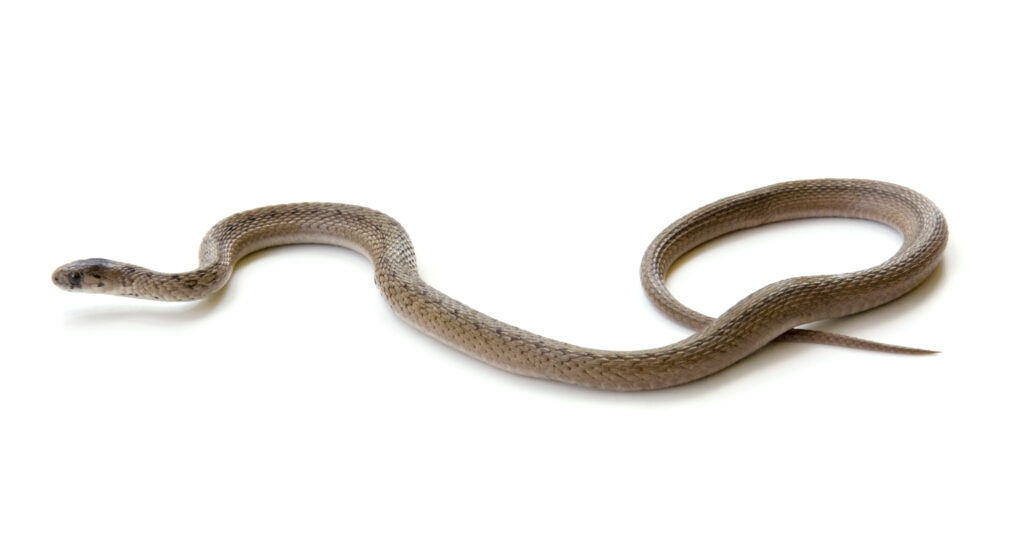
A perfect tiny little Northern Brownsnake just made my day. As soon as I saw her, I fell in love. She must be a few months old. Born this springtime. Gorgeous silvery-pewter colour. Perfect little head, smaller than half the size of my pinky fingernail. Alert and unbelievably cute.
I’m not sure why she was brought in to TWC. Senior staff member D said that she didn’t find anything wrong with her. But now that it’s November and she is not in hibernation, she might have to stay at TWC over winter until it is warm enough to release her back into the wild.
So I set up a little enclosure for her. A small aquarium with a very, very fine double mesh lid. Bricks to hold down the lid securely. Newspaper on the bottom, then filled the aquarium about two inches high with coconut substrate.
Why coconut substrate? It’s like a cross between soil and a very fine mulch. The fibers are soft, naturally anti-microbial, very absorbent, resist mold, and it is great for burrowing into. The alternative would have been paper towel bottom with shredded paper for the little snake to move around in. Not nearly as nice for her.
After setting the substrate, I put in a hide for her. A plastic dome that looks like a rock with a cave opening on one side. And I found a small plastic box with round entrance/exit hole in one end, to be her humidity box. Substrate was placed in it up to the hole, I dampened that substrate, and placed the box in her enclosure. A small water dish, made from a clean blue plastic jar lid, was filled halfway with water and placed in a corner.
D then brought her out from the Assessment room. She was hiding and staying warm in the folds of a towel that was in the small critter carrier for her, until we moved her into her new enclosure.
Once she was safely moved, I got her two micro mealworms and two phoenix worms, and D found a tiny baby earthworm. We put these in the enclosure so she would have something to eat when she felt ready. It’s hard to find food small enough for her! Her head is smaller than the eraser on a mechanical pencil.
She brought back memories of Long John Slither, my childhood pet. When I was little, I studied snakes and I had asked my mom for one for more than a year. She thought it was a phase that would pass. We ended up purchasing Slither, a Garder Snake, from a local pet store when he was a tiny baby.
L. J. Slither was a beloved family member with us for 4 or 5 years when I was in elementary school. I still have photo albums of his sheddings and photos of us together. Seeing this sweet little wild brownsnake, I couldn’t help think of Slither. Of course, this little one will be at the TWC only until it is safe for her to be returned to her home in the urban wild.
Northern Brownsnakes, a.k.a. Dekay’s Brownsnakes, are pretty common in Ontario. Smaller than other snakes. And totally harmless. I have only seen snakes in the daytime, so I didn’t realize until now that they are mostly (though not totally) nocturnal. This one is too young for the rows of dots down her back to be visible yet.
Her enclosure was placed on a heating pad in front of the viewing window. So that people bringing in new patients, and visitors to the Toronto Wildlife Centre, can see this beautiful little brownsnake while she is with us.